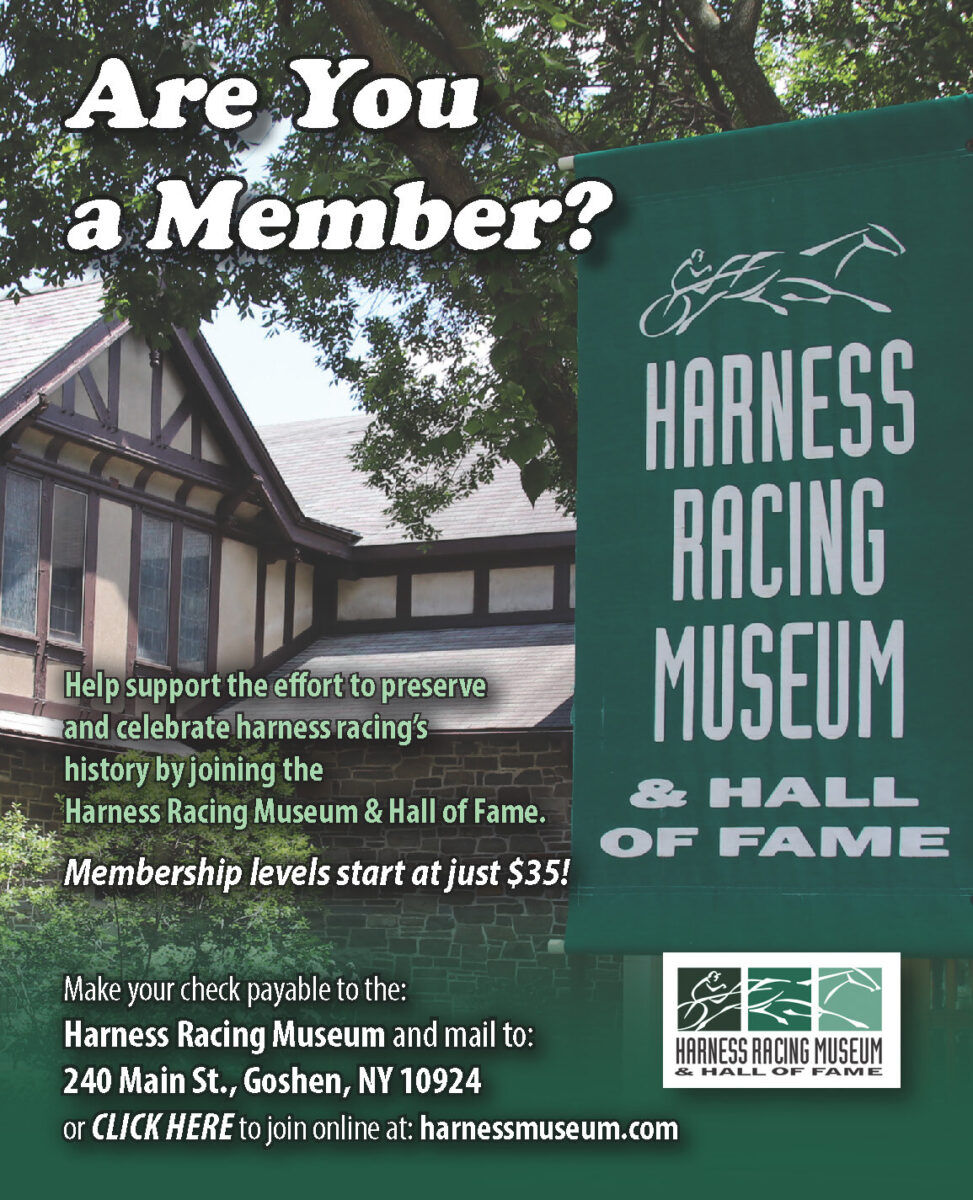My grandfather’s Hambletonian garage
A journey through 94 years of Hambletonian history as time stamped by my grandfather’s rental property and my sweet classic car.
by David Mattia for The Hambletonian Society
In 1926, Grauman’s Chinese Theater opened on Hollywood Boulevard, my grandparents built their first home, and harness racing ran its very first edition of The Hambletonian in Syracuse, NY.
The race was won by Guy McKinney for driver/trainer Nat Ray. The race time of 2:04.3 took home the largest piece of the $76,451 purse. At the time, with that kind of coin, you could have gone to Grauman’s and watched Rudolph Valentino in “The Son of The Sheik” about 19,000 times – popcorn included. I don’t know how they split up the monies back then, but the whole enchilada would be worth about $1,070,000 today.
Nearly three hundred miles to the south, my paternal grandparents built their very first home in northern New Jersey. They already had a big family, so they built a big house. Things were going great for my grandfather in 1926, so, for an extra $700, he bought the adjacent lot just in case he wanted to expand.
In the summer of 1932, with three additional children, a pair of mooching in-laws and the Great Depression tugging at his wallet, Gramps decided that the second lot needed more than just some rose bushes, a picnic table, and a cherry tree. Selling it was out of the question because the stock market crash had rendered it worthless. What could Gramps do to generate some income from that extra land?
Meanwhile, as Gramps was formulating a plan, a magnificently tall filly, The Marchioness, won the 1932 Hambletonian at Good Time Park in Goshen, NY for driver/trainer William Caton. While the crumbling economy had depressed the purse to $49,489 – about $940,000 in 2020 money — the race was anything but depressing. At a time when many Americans weren’t working at all, The Marchioness worked enough for everyone to ensure victory in a race that required four heats to determine a winner.
On Sept. 17, 1932, exactly one month after the achievements of The Marchioness, Gramps went to the Town Hall with a set of plans. They were approved, and within days, he and my great-grandfather, a man I never knew, started the construction of a three-car garage that would hopefully generate rental income on the double lot. The cost for building it was exactly $807.42 ($12,000 today).
By the summer of 1933, the year that another filly named Mary Reynolds won the Hambletonian for driver/trainer Ben White, the garage was almost complete. There was a brief delay in finishing because my grandfather was toying with the idea of turning the upper part of the garage into an apartment. It was decided by my grandmother that the cost of doing this was prohibitive, and there was no way on earth my grumpy grandfather could ever get along with a tenant living on his property. So, rather than arguing about cost-effectiveness, the whole thing was topped off with a high vaulted ceiling.
Keep in mind that this was an unreasonably big stand-alone garage. My father said that it was big enough to fit three 1930 Cords. Did you ever see a 1930 Cord? Jay Leno has a few of them in his antique car collection. You don’t park those things. You dock them.
In 1934, as the garage was topped off, and the Great Depression was at its worst, the Hambletonian purse had dwindled down to a paltry $25,845 — the lowest Hambletonian purse ever. The wounded purse notwithstanding, that year’s Hambletonian was still a grand and well-attended event that saw Lord Jim winning with Hugh M. “Doc” Parshall driving and training.
Although the standardbred was still a relatively young breed, Lord Jim, the least expensive yearling to ever win the Hambletonian, was already an heir to some antiquated breeding. His sire, Lord Axworthy, did not sire Lord Jim until he was 28, and his dam, Selka, a mare by Peter the Great, was 16 when she foaled him. Being genetically outdated didn’t matter to Lord Jim. In a four-heat Hambletonian, Lord Jim wore down the highly-regarded Muscletone to get up and win in 2:04.1.
While Lord Jim was still basking in the glory of being a Hambletonian champ, my grandfather handed a garage key to a man named Mr. Brady, his very first garage renter. Mr. Brady was a middle-aged bachelor who lived in a nearby apartment building with his elderly mother. I don’t know what kind of car it was, but my grandmother always referred to it as a big black monstrosity that was rarely used and kept immaculately clean. My grandfather was annoyed by Mr. Brady’s presence simply because he was often polishing his car and tinkering under the hood. But he always paid his rent in advance at a time when money was hard to come by.
Along our journey to my next Hambletonian Garage connection, I’d like to tell you a little bit about the garage itself.
Before there was Monty Hall and the game show Let’s Make a Deal, and long before I came into the world, there was my grandfather’s garage. It was just like the show.
From left to right, there was Door #1, Door #2 and Door #3, and each door had the number printed on it in large numerals. This was totally unnecessary, but that was the way my grandfather did things. For example, when he kept cash in his house, the $1 bills were kept in the tin for small Band-Aids. Five-dollar bills were kept in the tin for medium sized Band-Aids and anything larger than a five was kept in the tin for extra-large Band-Aids. The amateur psychiatrist in me suspects that my grandfather thought that money and bandages performed the same service.
The door closest to the house was Door #3. You could drive straight into that spot because the driveway led directly up to it. Gramps planned on charging the most for that spot, but until he could find a renter, he parked his own car there.
Door #2, the door assigned to Mr. Brady, was a little tougher. You had to turn left at the top of the drive and straighten out nimbly to pull straight in. Because of that small nuisance, it was a little less expensive than Door #3.
Door #1 was the least expensive because it was exceedingly difficult to maneuver. You had to make a hard left at the top of the driveway and pull up and back a few times until you were positioned directly under the cherry tree. After that, you could level out and drive on in.
In 1939, when my father was a baby, Gramps lowered the price just enough to finally snag someone to rent Door #1. Its first occupant was a prison matron named Miss Beck. My dad remembered her because she would garage the same car there for over 20 years. Dad said that Miss Beck was a powerful woman. I guess you had to be powerful to be a prison matron back in the 1930s and 40s. With no power steering to help her, Miss Beck maneuvered her 1937 Oldsmobile in and out of Door #1 every day without ever once taking out the cherry tree.
If my grandfather hadn’t been so stubborn about his rental prices, he could have rented out all the spots earlier in 1935 or 1936. Then I would have an excuse to mention the immortal Greyhound and the legendary Rosalind – the greatest Cinderella story in the history of the Hambletonian. I’ve decided to sneak them in anyway with the idea that plenty of people probably wanted to rent the spot throughout those two years but begged off when told about the outrageous price of $5 per month.
In the summer of 1939, Grandpa’s garage was two-thirds rented, the Great Depression was fading from the headlines and Mr. Brady, a timid bachelor whose favorite color was plaid, and Miss Beck, a lady wrestler disguised as a prison matron, were parked side by side. Everyone expected love to bloom for the late-in-life couple, but it never happened. My dad said that Mr. Brady wouldn’t have survived the honeymoon.
Anyway, in 1939, with an American involvement in the European war becoming increasingly inevitable, the Hambletonian Trophy went again to trainer/driver Doc Parshall and the horse Peter Astra – a Peter Volo colt who sold as a yearling for the sizeable sum of $3,250 – that’s about $60,000 today.
Initially, the owner, a physician named Dr. L.M. Guilinger, kept the colt’s ownership secret. He feared that his patients wouldn’t expect a bill for services rendered from a doctor with that much money to spend on a horse. The average physician earned about $7,500 per year in 1939, while the average patient, if they were lucky enough to have a job, earned a little less than $1,200.
It was also the year when the priceless Hambletonian Trophy that we now know was crafted. It’s on display at the Meadowlands Racetrack on the Clubhouse level.
Until someone decided that the trophy was too valuable to lend out, it was presented to the winning connections to have and to hold for one year. Today, the original Hambletonian Trophy is only trotted out, so to speak, for ceremonial reasons. It’s presented to the winning connections for the photo-op. When all the race day hoopla is over, the trophy is inscribed with the necessary inscriptions, and returned to its display case. The winners receive a replica in its place.
The Hambletonian stuff is easy for me to write about because most of it is programed into my brain, and whatever I don’t know, I can easily look up. However, the ancient history of the garage is quite different. Almost all the old-time stuff was told to me by my dad and the last of my surviving relatives on my dad’s side of the family.
Anyway, the years went by without me existing on the earth. Garage tenants and their cars came and went, everyone got old, the prison matron died of a heart attack trying to steer her car into Door #1, and the Hambletonian was still the grandest event in harness racing. Then, after four billion years of a blissful non-existence, I came along. Oh, and I’m kidding about the prison matron. I don’t know what became of her, but she was in her 50s in the 1930s. So, unless she’s the oldest person on earth, I suspect she’s no longer with us. It’s safe to say that however old she lived to be, she’d have lived at least five years longer if she either had power steering or enough money to rent garage Door #3.
Remember earlier when I told you about Mr. Brady, the old guy who rented garage Door #2 way back in 1934? Yeah, well, he lived to be nearly 100 years old and I knew him. By this time, the mid 1970s, his car, which he still used, was a well-preserved 1957 Pontiac Star Chief. The fact that Mr. Brady would ultimately end up renting the same parking spot for about 60 years seems kind of freaky.
In 1957, the year Mr. Brady’s Pontiac rolled off the assembly line, Hickory Smoke won the Hambletonian for his driver/trainer John Simpson Sr. The historical importance here, apart from the fact that Hickory Smoke went on to be a high-impact stallion, is that 1957 was the year the Hambletonian moved to The Du Quoin State Fair in Du Quoin, IL.
The last quarter of the final heat was a smoking :28.4. The only thing on earth smoking more than Hickory Smoke was Mr. Brady’s 1957 Pontiac. It had a leaky head gasket. At least that’s how my father told the story.
In 1977, the year Green Speed won the Hambletonian with Billy Haughton training and driving, I knew all about harness racing. In fact, the very first horse I ever jogged at a training farm in Colt’s Neck, NJ was a little black horse who was sired by Ayres, the horse who won the 1964 Hambletonian. The year 1977 was also when Mr. Brady went to that great garage in the sky.
Sadly, Mr. Brady was gone, but sadder still was the fact that his car wasn’t. As meticulous with his money as he was with his cars, Mr. Brady departed this world with his garage rent paid for a year in advance, or until his nephew in San Diego, his only surviving heir, came to either claim it or provide for its removal.
In the summer of 1977, I was assigned the chore of mowing the lawn for my home and my grandparent’s home which was about 50 yards down the road. Both houses had big gardens and trees, so there were only a few medium-sized patches of actual lawn to mow. It wasn’t hard work. I did neighbors’ lawns for extra money, but the family lawn thing was my very first scheduled job for which I was paid. The only problem was that I had no access to gasoline for the mower.
I didn’t dare ask my grandfather for gas because his grouchiness had grown incrementally over the years. The last thing he’d do was reach into his Band-Aid tins for a few bucks. The guy at the gas station wouldn’t sell gas to a kid with a can, so, when I ran out of gas, instead of abandoning my job, I did what any entrepreneurial kid would do, I siphoned it out of Mr. Brady’s ancient Pontiac.
Let me tell you why taking Mr. Brady’s gas seemed perfectly acceptable to me.
By the time I was 12, I had seen the movie THE BAD SEED on TV about 10 times. It’s an iconic film from 1956 – the year The Intruder won the Hambletonian for Ned Bower. Most people have seen the film, but for the record, it’s the psychological drama about a perfectly polite little girl named Rhoda Penmark who secretly kills a schoolmate named Claude Daigle because he won the penmanship medal and she didn’t. After pulling the penmanship medal off his lapel, Rhoda pushes poor little Claude off a pier at a school picnic and he drowns. No one suspects perfectly pretty Rhoda, but when Rhoda hears her mother say how brokenhearted Mrs. Daigle was about not being able to bury her boy with his treasured penmanship medal, Rhoda callously says, “Claude is dead. He won’t know if the penmanship medal is pinned on him or not.”
Rhoda Penmark taught me well because that’s what I figured about Mr. Brady. No, I didn’t murder him, but he was dead, he wouldn’t know if his old car had gas in the tank or not.
Throughout the next five years, I paid little attention to the contents of the garage, although, by this time, there was a mysterious car behind Door #1 that seemed to be there for as long as I could remember. Basically, that’s what this story is all about, but I took the long route to get here. This was a time when my 17th birthday was fast approaching. I was already involved in harness racing, but how that happened is a much shorter story than this.
Anyway, Gramps, no longer driving, kept his Oldsmobile Delta 88 parked behind Door #3, and believe it or not, Mr. Brady’s prehistoric 1957 Pontiac, my own private Exxon station, was still there. His nephew just kept sending rent checks year after year. This annoyed my grandfather because he couldn’t raise the rent for a new tenant. And then there was that mystery car behind Door #1. What was that all about?
It was obviously a car, but it was covered in a giant tarp that was secured all around by plastic rope. Atop the tarp was a car-sized swatch of burlap. On top of the burlap my grandfather had piled a bunch of paint cans and carpentry stuff on what would be the hood and the trunk of the car. I couldn’t even tell which way the car was facing.
Days before I turned 17, and dreaming about a car of my own, the unthinkable happened. Mr. Brady’s nephew showed up. Despite having sat there for ages, the old Pontiac Star Chief started right up with jumper cables. It ran and smoked for a few minutes and then sputtered out. After a short while, a huddle of men determined that the car was out of gas. Of course, I’d already figured that out because I’d siphoned gas out of that car for four summers, but I wasn’t about to tell anyone.
Ten minutes after Mr. Brady’s car was hauled away, my Aunt Helen, a woman who never drove, pulled her car into Mr. Brady’s spot. For me, it seemed like Aunt Helen was grave robbing. Mr. Brady’s crypt should’ve been given a little more reverence. Aunt Helen’s car was a gruesomely silver 1975 Chevy Impala with red interior, a red landau top and a lot of rust. Silver and red and rusty? Does it get any uglier than that? I mean, Mr. Brady’s car may have been old and smokey, but it had class. This was a miserable day for Door #2.
Although Aunt Helen’s car was a 1975 model, it was manufactured in 1974, the year when Bonefish won the Hambletonian for the immortal Stanley Dancer. In that race, Bonefish set a world record for four heats divided. Stanley Dancer figures largely, albeit briefly, in this story, so keep reading.
After turning 17, unlike most eager kids, I waited a few months to get my driver’s license. When I acquired one, my father said he had a surprise for me. I figured that the surprise was a car, but I worried that I’d get my grandfather’s old man’s Oldsmobile, or worse yet, my Aunt Helen’s car that looked like a lampshade in a brothel.
A few days later, my dad marched me over to the garage and handed me a key. In my head, I heard Monty Hall say, “Will it be Door #1, Door #2 or Door #3?
It was totally demented. I had to try the key in each door to see which car I would get. I figured there was no way it could be the key to Door #1, so to add to the suspense and give my dad a thrill, I tried Door #1 first. Remember that behind Door #1 was the old car under the tarp. I put the key in the lock, turned it, and it opened. What fresh hell was this?
Using one try, I discovered that my gift car was the mysterious creature that lay beneath the dusty tarp and burlap, only now there were more paint cans, more mover’s quilts, and more dust. Figures that my older brother was driving around in an Audi and I was the brother who got zonked, but at least I never had acne. Over the years, so much junk was piled up on top of that car that almost everyone, except for my father, had forgotten about it.
When the junk was cleared, the tarp was pulled back to reveal something astonishing.
Do you remember the scene in the movie AMADEUS when Salieri reads Mozart’s first and only draft of his Requiem? He says, “It was miraculous!”
You’re probably thinking that the car beneath the tarp was something like a 1920s Duesenberg Roadster or the 1929 Isotta Fraschini that Norma Desmond owned in the movie SUNSET BLVD, but no. It wasn’t anything as elaborate as all that. It was even better.
When I was 17, we didn’t have TV shows like Antique Roadshow or Jay Leno’s Garage or My Strange Inheritance, so I didn’t put a lot of thought into what auto-treasure might lie beneath the tarp. Cars, old or new, didn’t interest me all that much anyway, but in an instant, all of that changed.
Hidden beneath that tarp for all those years was a 1965 Buick Special convertible. By this time, it was practically a relic, at least in my mind, but it was in mint condition. In 1965, while my grandfather waited on his special order (he wanted a bigger engine) Egyptian Candor won the Hambletonian for driver Del Cameron and trainer Stanley Dancer.
Made in Detroit, painted in Arctic White – an official Buick color — with a white convertible top to match, it was a mid-sized masterpiece. For the price of $2,889, my grandfather had ordered the car from Ray Auer Buick in Red Bank, NJ, but after he drove it, he decided that he didn’t like it. He said it was too sporty or something, so he put about 6,000 miles on it and stuck it in the garage to be used as a shelf. I guess the fact that it weighed three tons less than the cars he was used to made it feel “flimsy” to him.
At first glance, the car amazed me, but I worried that it might draw in unwanted attention. Keep in mind that this car was from a different era. There was a tremendous difference between 1960s cars and 1980s cars. The styling had changed drastically. This was the MTV generation, but I’d be driving around in something straight out of the Zapruder Film.
For the price of $390.00, and I still have the receipts, the car was tuned up, got a new battery and was fitted with new tires that I had to get on special order from Sears because they were the only place that carried them. The whitewall tires had a wider whitewall strip, and that made all the difference. I didn’t have to do this, but they matched the original tires which had to be replaced anyway. I also buffed up the “Ray Auer Buick” bumper tag because it was supposedly a high-class dealership back in the day. I figured it added a little provenance to the car.
Okay, for you MY COUSIN VINNY fans out there, aside from the convertible top, this was the same car that came into question during Ralph Maccio’s murder trial. Remember when Marissa Tomei gets the case dismissed because she’s an expert mechanic, and Joe Pesci shows the jury some pictures of those skid marks? And then there’s that whole thing about the positive-traction rear differential being a different model Buick? Yeah, well my Buick, the one that belonged to the real killers, is the car we’re talking about. My Buick Special — not the Skylark — had the positive-traction rear differential. The only difference between the Skylark and the Special were the taillights and the drive train. Otherwise, it was the same car.
Of course, like with most family heirlooms, the gift car came with a stipulation. I had to give up my spot behind Door #1. I knew there had to be a catch. Seems I was evicted in favor of a paying tenant. I didn’t think that was fair. My grandfather had died in 1981, so the evil voice of Rhoda Penmark in my head snarled, “Grandpa is dead. He won’t know if I’m paying rent or not!”
Another thing that Gramps would never know was that 1981 was the very first year the Hambletonian was held at the Meadowlands Racetrack. The first Big M winner, Shiaway St Pat, trained and driven by Ray Remmen, was, just like every car that ever parked in my grandfather’s garage, bred in Michigan.
I didn’t really care about losing the parking spot. It was easier to park under the old cherry tree anyway, but parking a white convertible under a cherry tree – between the birds and the fruit – wasn’t exactly a genius move, and I would have that ragtop replaced three times during the car’s 10-year tenure with me.
The following week, with the top down, I introduced my Buick to the harness racing world. As I drove down Route 9 towards Freehold Raceway, I noticed a few heads turning. Like I said, styles had changed drastically, and cars from that era didn’t last exceptionally long. It’s not like today where my 2002 GMC Sport-Side pickup looks almost the same as its 2020 version. At that time, seeing an older car in that kind of condition was rare.
I pulled my car into a spot near the Freehold race office. Back then, the race office was on the other side of the highway and you had to walk up an outdoor staircase to get to it. That’s when I saw Stanley Dancer coming down the steps. I’d seen him in races, and he’d won the Hambletonian four times, but I had never seen him in person. He was a real-life human… and he was walking towards me with a wide-eyed smile.
He said, “Where did you get this car?” I stammered that it was given to me by my father and that it had been my grandfather’s car. Almost amazed, he walked around my car and gave it a buyer’s going over. He asked to peek under the hood and was doubly impressed when he saw the Wildcat 310 engine. Then he noticed the Ray Auer Buick logo on the rear bumper. He said, “Ray Auer sold nice cars. I knew him. This car is a real beauty. Good luck with it.” Then he walked away.
That was surreal, but not as unusual as the time, years later, when I sat on the ground with the immortal Herve Filion and helped him change his flat tire. As we struggled with a seized lug nut, Herve said, “Whatever happened to your white convertible?”
Right around the time Stanley Dancer took a shine to my car, the great Howard Beissinger– he won theHambletonian in 1978 with Speedy Somolli – said that my car was, “a terrific piece of work,” when he saw it parked behind his barn at the Meadowlands.
When I was stabled at Meadow Run Farm in southern New Jersey, Harry Harvey – Helicopter 1953 – admired my car, but he warned me that it would eventually start to smell like horses. He was right about that. He was also right when he told me that my tiny horse, Texas Bound, needed to be trained as though he was a big horse. When I followed his advice, Texas Bound went from being a cheap horse who never won, to being a cheap horse who won a lot.
The compliment I remember most fondly was when one of my favorite harness racing drivers, Mickey McNichol, someone I think of as a good friend and mentor, said to me, “Where the hell did you get this car!” The thing that makes it so memorable for me is that Mickey McNichol’s Hambletonian victory with Alf Palema in 1992, still reigns today as my all-time favorite Hambletonian. I was happy to see Mickey win it, and I thought at the time, that Alf Palema was one of the most magnificent trotters I had ever seen.
Naturally, as with all things of beauty, there was a dark side to the life of my beautiful car. In 1985 – Prakas with Bill O’Donnell in the bike for Per Eriksson – my car was stolen from the Meadowlands parking lot and showed up two weeks later in the parking lot of Roosevelt Raceway. A sharp detective would have deduced that the thief probably liked harness racing.
After it was towed by the Westbury police, the careless guy who oversaw the impound lot out on Long Island had tossed it onto a pile of abandoned cars. It took every cent I had to get it repaired. Using body parts from a junked Skylark, my car had to be fitted with Skylark trim and repainted.
The car would again be stolen in 1986 – Nuclear Kosmos with Ulf Thoreson driving for Per Henriksen. It was found a few days later lying in a ditch near the Passaic River. I had it fixed again but it was losing its luster.
In 1987— Mack Lobell with John Campbell driving for Chuck Sylvester — my poor car was yet again snatched from a city street. This time I found it myself. By 1992, my beautiful Buick that had caught the eye of some of the greatest Hambletonian horsemen in history, and several car thieves with a penchant for vintage cars, would end up being snagged five times.
When we were sitting in the dirt and Herve Filion asked me, “Whatever happened to your white convertible?” I told him that I didn’t know. To this day I still don’t really know because after its fifth abduction, it wasn’t located until 15 years later – which is a great story for another time.
So here we are in 2020, a year that’s been nothing but fun, and my nearly spotless 2002 GMC Sport Side Sierra sits in my garage, although I use it from time to time. The car seems so young to me because I remember buying it off the showroom floor in 2001 – the year Scarlet Knight won with Stefan Melander. The sad truth is that it’s actually older than my 1965 Buick was when I first laid eyes on it. And then there’s this neighbor kid, a 7-year-old boy, who is fascinated by my “old truck.” So, the cycle begins again. I’ve decided to either sell it to the kid when he’s old enough to drive, or to lay down and die and leave it with a full tank of gas just in case the kid goes into the lawn mower business. I’ll be dead. I won’t know if my car has gas in it or not.






















